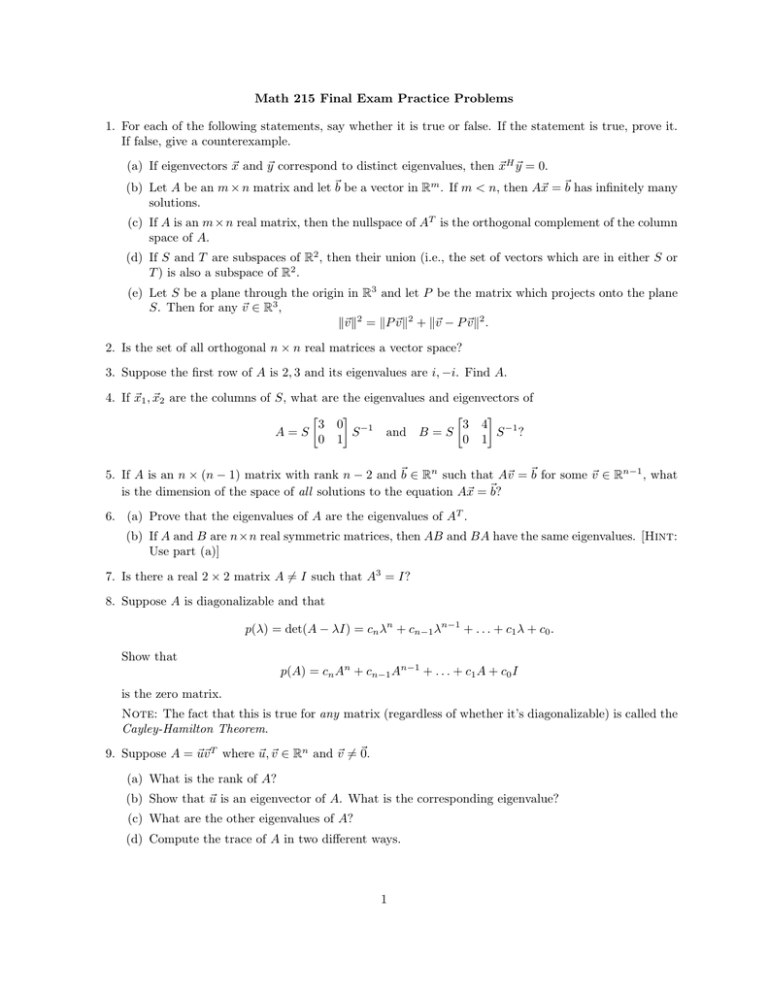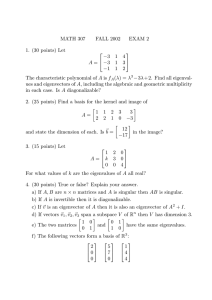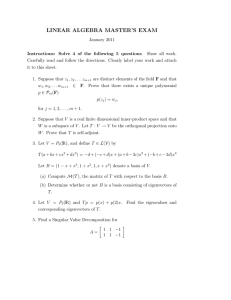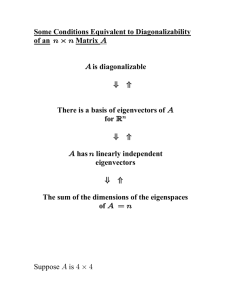Math 215 Final Exam Practice Problems
advertisement

Math 215 Final Exam Practice Problems
1. For each of the following statements, say whether it is true or false. If the statement is true, prove it.
If false, give a counterexample.
(a) If eigenvectors ~x and ~y correspond to distinct eigenvalues, then ~xH ~y = 0.
(b) Let A be an m × n matrix and let ~b be a vector in Rm . If m < n, then A~x = ~b has infinitely many
solutions.
(c) If A is an m × n real matrix, then the nullspace of AT is the orthogonal complement of the column
space of A.
(d) If S and T are subspaces of R2 , then their union (i.e., the set of vectors which are in either S or
T ) is also a subspace of R2 .
(e) Let S be a plane through the origin in R3 and let P be the matrix which projects onto the plane
S. Then for any ~v ∈ R3 ,
k~v k2 = kP ~v k2 + k~v − P ~v k2 .
2. Is the set of all orthogonal n × n real matrices a vector space?
3. Suppose the first row of A is 2, 3 and its eigenvalues are i, −i. Find A.
4. If ~x1 , ~x2 are the columns of S, what are the eigenvalues and eigenvectors of
3 0 −1
3 4 −1
A=S
S
and B = S
S ?
0 1
0 1
5. If A is an n × (n − 1) matrix with rank n − 2 and ~b ∈ Rn such that A~v = ~b for some ~v ∈ Rn−1 , what
is the dimension of the space of all solutions to the equation A~x = ~b?
6. (a) Prove that the eigenvalues of A are the eigenvalues of AT .
(b) If A and B are n×n real symmetric matrices, then AB and BA have the same eigenvalues. [Hint:
Use part (a)]
7. Is there a real 2 × 2 matrix A 6= I such that A3 = I?
8. Suppose A is diagonalizable and that
p(λ) = det(A − λI) = cn λn + cn−1 λn−1 + . . . + c1 λ + c0 .
Show that
p(A) = cn An + cn−1 An−1 + . . . + c1 A + c0 I
is the zero matrix.
Note: The fact that this is true for any matrix (regardless of whether it’s diagonalizable) is called the
Cayley-Hamilton Theorem.
9. Suppose A = ~u~v T where ~u, ~v ∈ Rn and ~v 6= ~0.
(a) What is the rank of A?
(b) Show that ~u is an eigenvector of A. What is the corresponding eigenvalue?
(c) What are the other eigenvalues of A?
(d) Compute the trace of A in two different ways.
1
10. Let V be an n-dimensional vector space and suppose T : V → V is a linear transformation such that
the range of T is equal to the set of vectors that T sends to ~0. In other words,
{T (~v ) : ~v ∈ V } = {~v ∈ V : T (~v ) = ~0}.
(a) Show that n must be even.
(b) Give an example of such a T .
11. Find the LU decomposition of the matrix
3 −1
−3 −2
9 −5
12. Let A be the matrix
A=
2
10 .
6
−2 2
1 −1
and suppose ~u(t) solves the differential equation
d~u
= A~u(t)
dt
subject to the initial condition ~u(0) =
1
. What happens to ~u(t) as t → ∞?
4
2








